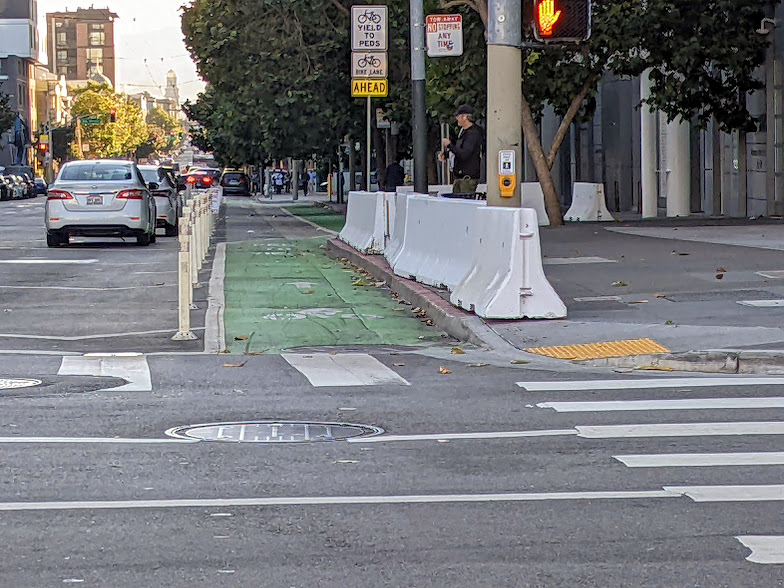Note: GJEL Accident Attorneys regularly sponsors coverage on Streetsblog San Francisco and Streetsblog California. Unless noted in the story, GJEL Accident Attorneys is not consulted for the content or editorial direction of the sponsored content.
The city of San Francisco pushed out the unhoused, "cleaned up" the adjoining streets, and pedestrianized Howard Street between 3rd and Fourth around Moscone Center for last week's Dreamforce convention. To help protect the building from runaway vehicles, they used concrete barriers--the very kind this publication has advocated for ad nausea to protect the lives of cyclists and pedestrians.
As the San Francisco Chronicle Reported:
City officials weren’t revealing their strategies for keeping the few blocks surrounding Dreamforce clear and clean, but it was evident this week that extra effort went into that goal. Homeless people and panhandlers have a right to hang out if they’re not disturbing anyone or blocking passageways, but they did seem to get the message from the endless streams of police, smiling city street ambassadors and security forces that they should steer clear for now.
This gets at the crux of why advocates should never accept when cities tell them they can't make things safe for people who get around on two wheels. Of course they can, by using the same tools San Francisco just used to block off streets and protect sidewalks for the convention. But Jersey barriers should be used to save lives, and not just when there are convention goers in-town.

But morally confused bureaucrats and careerist officials believe, correctly, that it's in their interest to temporarily erect concrete barriers to protect those attending a $90 million conference, while residents and commuters are left with plastic bollards, and green and white paint. So they just did it.
In other words, Salesforce's Mark Benioff draws a lot of proverbial water in this town.
Cyclists and pedestrians, including dead children apparently, not so much.
Meanwhile, other cities are doing exactly what's needed, employing boulders, concrete, cast-iron, and whatever else it takes to make streets safe for its citizens. Streetsblog New York is celebrating the installation of concrete barriers all across the city. Santa Monica Next is showing it is not nearly as hard to put in permanent concrete barriers as many people pretend. Paris is also putting down concrete.
As the Marin County Bicycle Coalition put it on Twitter:
It's called a jersey barrier*, folks.
— Warren J. Wells, AICP 🚴🏙️🦀 (@WarrenJWells) September 18, 2023
You put it between bikes and cars, and everyone is better off.
It's just not that complicated.
*"k-rail" in California https://t.co/cD6fBXBGDq
But in San Francisco, with a couple of rare exceptions, it's still plastic and paint. Unbelievably, San Francisco couldn't even put the temporary Salesforce Jersey Barrier to the left of the bike lane where it would protect cyclists and pedestrians. They could have put them in the correct position and just left them there and that would have been something permanent for the people that live, work and play in the city for more than one week per year.
I stumbled upon these new @NYC_DOT interventions on Underhill in Brooklyn yesterday and I hope this becomes the toolkit for neighborhood streets across the city. Apart from the noticeably calmed traffic, gotta love how many parking spaces went to the wood chipper for this 😎 pic.twitter.com/HdSq4SjRJy
— Travis R. Eby (@travis_robert) September 18, 2023
Advocates need to get the right leaders into office and into the key bureaucratic positions. Think Janette Sadik-Khan who set things in motion in New York and Anne Hidalgo of Paris. That kind of leadership is clearly still lacking in a city where a one-week convention holds more sway than the advocates who toil tirelessly to make the city a safer place to be.






